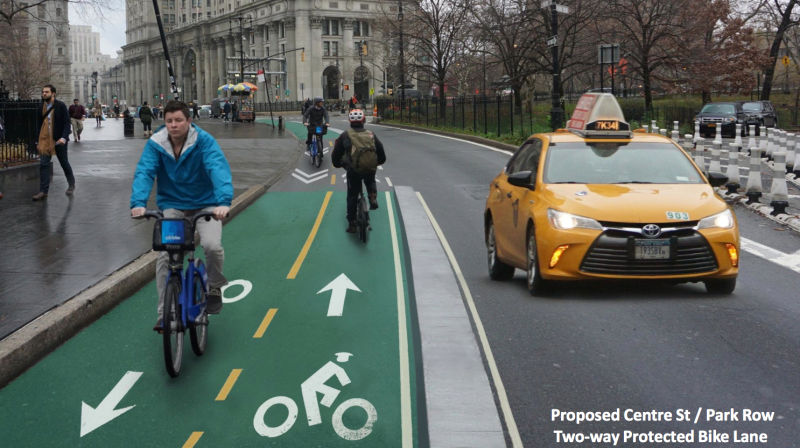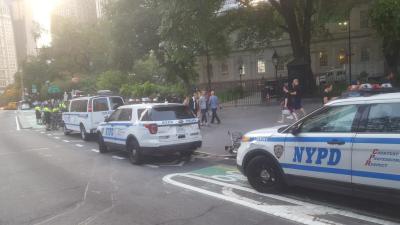DOT Has a Fix for the Crummy Bike Connection Between Lower Manhattan and the Brooklyn Bridge

DOT is looking to fix the stressful connection between the Lower Manhattan street grid and the Brooklyn Bridge bike path with a short, two-way protected bike lane on Park Row [PDF].
Currently, there are no good options for cyclists. If you’re biking off the bridge, you head right into a row of police cars, press vans, and other vehicles with parking placards — they’re all stationed in what’s supposed to be a short stretch of southbound buffered bike lane on Park Row. Heading toward the bridge, cyclists are expected to go out of their way to take hectic Church Street and approach the bike path entrance through City Hall Park — many end up breaking the rules and riding against traffic on Park Row instead.
The big change in DOT’s plan is a two-way section of bike lane protected by a concrete barrier on Park Row, plus a short contraflow lane on Spruce Street. It’s not a lot of bike lane mileage, but it’s a key link in the network that will be dramatically improved:
“We know there are a lot of cyclists coming from Lower Manhattan,” said DOT Bicycle and Pedestrian Program Director Sean Quinn. “Almost half the cyclists are going the wrong way on Park Row or on the sidewalk. We knew we could capitalize on a route that people are already doing.”
Quinn said the agency wants to get something done this year to improve the Manhattan side of the bridge, complementing the capital project on the Brooklyn approach to the bridge, which is currently in progress.
There will be two gaps in the concrete barrier on Park Row for vehicle access to City Hall, the press vans will be shifted to an area along the median, and police will be directed to use space north of Spruce Street as a drop-off zone. DOT’s also planning to extend concrete medians into four crosswalks on Park Row.
Between Spruce and the Battery, the project mainly calls for sharrows to direct cyclists along a network of narrow streets leading to and from the bridge.
DOT presented the project to Manhattan Community Board 1 on Monday. The board did not vote but indicated support for the project, and DOT is moving forward, with implementation anticipated for late spring or early summer.




